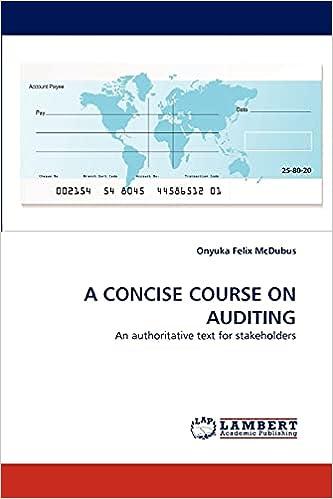Answered step by step
Verified Expert Solution
Question
1 Approved Answer
January 1 You started the business by contributing $100,000 of personal capital in exchange for common stock January 1 Paid $5,000 to the lawyers to
- January 1 You started the business by contributing $100,000 of personal capital in exchange for common stock
- January 1 Paid $5,000 to the lawyers to incorporate your business entity
- January 2 Acquired computers for the business for $5,000
- January 3 Acquired inventory held for re-sale for $20,000
- January 4 First sale took place, as you sold half of the inventory originally purchased. You sold it for $50,000 cash.
- January 14 Customer in event #5 realized an error he made in his order and returned inventory, which is still in great condition, which had a revenue value of $2,000. You added this returned product to inventory and returned the $2,000 cash.
- January 31- You made your first month payment for accounting software, which you will continue to pay monthly, on the last day of each month for the remainder of the year. The monthly fee is $95.
- March 1 Pre-Paid $12,000 for a one-year lease of a small office to be used for administrative work only.
- March 1 Acquired office furniture for $10,000 cash. Estimated useful life is five years with a $200 salvage value, using straight-line depreciation.
- February 15 Sold the rest of the inventory for $75,000 cash
- March 15 You were sued by an outside party, and received an invoice from lawyers for $2,000 for legal work performed, due in April.
- April 1 Paid the legal invoice due
- April 15 Paid an IT contractor $500 to repair your computer.
- April 25 Bought more inventory from your supplier, for $20,000 on credit
- May 1 Borrowed $100,000 from the bank at a simple interest annual rate of 10%. No principle or interest is due this year.
- May 31 Sold all remaining inventory for $50,000, on credit.
- June 30 Collected on all outstanding Accounts Receivable.
- July 1 Paid all $20,000 of accounts payable from April 25.
- July 15 Sold all of the computers for $1,000 in cash.
- September 1 Bought more inventory, for $30,000 using a one-year note payable, which has a 12% annual simple interest rate.
- October 1 Sold inventory all that you had on hand, for $50,000 on credit.
- October 1 You hired your first employee to perform administrative work.
- November 5 You paid $5,000 cash for wages that were earned in October. You continue to pay the same amount on the 5th of each month for wages earned the previous month.
- November 1 Collected on accounts receivable, in all cash.
- November 18 Bought inventory for $25,000 on credit
- December 1 You had $2,000 of you inventory stolen.
- December 15 You were declared business-of-the-Month by your local Chamber of Commerce. You paid $110 to attend a banquet in your honor.
- December 20 Your employee qualified for health insurance. You paid $1,000 directly to the insurance company for December health insurance coverage.
- December 31 Recorded accrued interest from the bank loan.
- December 31 Paid $5,000 bonus in cash to employee.
- December 31 Recorded depreciation on office furniture (record a full year of depreciation)
- December 31 Recorded lease/rent expense from pre-payment.
- December 31 Recorded accrued salary
- December 31 Recorded accrued interest on the note payable.
- December 31 After books were closed, you paid 50% of all the remaining profit as cash dividend.
Step by Step Solution
There are 3 Steps involved in it
Step: 1

Get Instant Access to Expert-Tailored Solutions
See step-by-step solutions with expert insights and AI powered tools for academic success
Step: 2

Step: 3

Ace Your Homework with AI
Get the answers you need in no time with our AI-driven, step-by-step assistance
Get Started


